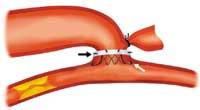Seamless Earth-vein Relationship

This mechanism was developed by an American group from Minneapolis (St. Jude Medical Anastomotic Technology Group). In the animals it was shown that they could perform coronary anastomosis in less than 3 minutes and with little formation.
In the University Hospital of Bern they have tried for the first time the mechanism with a patient of 61 years and have obtained a very satisfactory result. The patient had acute angina pectoris and in cardiac intervention the coronary artery should join the safena vein. The new mechanism avoided sewing.
The coronary connector is a stainless steel balloon placed on a carrier blood device. The connector has external fingers to chain the venous grafts and inner fingers to put them in the plumage of the artery. The blood catheter, by increasing the pressure, simultaneously inflates the connector (making anastomosis) and shortens the length. In this way it tightens the vein graft against the coronary artery and achieves a hemostatic closure.
The 61-year-old patient was intervened in November and discharged after 9 days in the hospital. It took much less time than in hand-sewn operations and since then blood flow has an optimal rhythm. Therefore, the benefits of this mechanism have been revealed and recommend its use in other hospitals.
Buletina
Bidali zure helbide elektronikoa eta jaso asteroko buletina zure sarrera-ontzian











